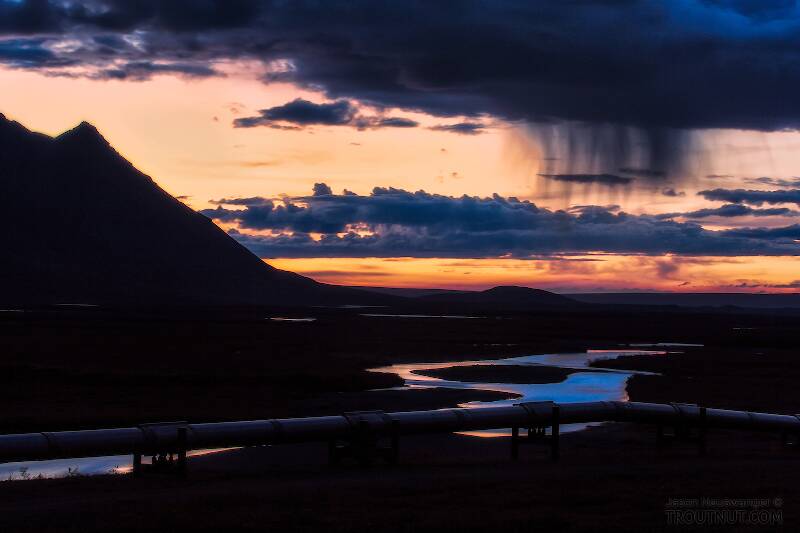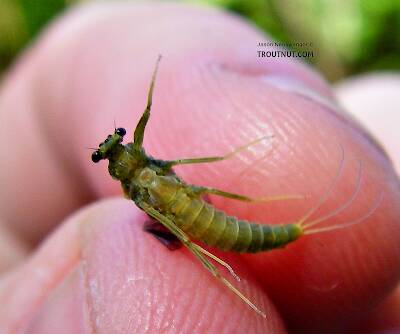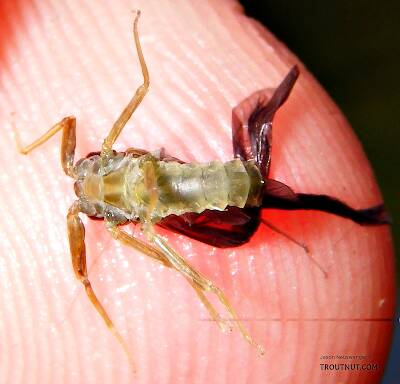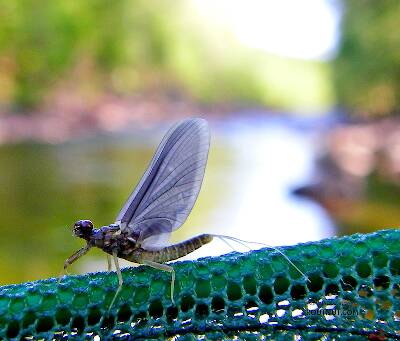
Hex Mayflies
Hexagenia limbata
The famous nocturnal Hex hatch of the Midwest (and a few other lucky locations) stirs to the surface mythically large brown trout that only touch streamers for the rest of the year.


Mayfly Species Drunella lata (Small Blue-Winged Olives)
Currently, Drunella lata shares its name with another mayfly, the former D. longicornis. That mayfly can be important in mountainous areas in the Southeast, but they are larger and the nymphs lack the distinctive pale markings mentioned in the Juvenile Characteristics section. (The information on this page does not describe D. longicornis)
Where & when
Time of year : End of June through August, depending on location
Preferred waters: Usually most abundant in larger streams and rivers
In 7 records from GBIF, adults of this species have been collected during July (57%), August (29%), and June (14%).
In 3 records from GBIF, this species has been collected at elevations of 981, 1909, and 2625 ft.
Species Range
Hatching behavior
Emergence can be scattered and sporadic, though more concentrated emergence tends to happen early in the morning during heatwaves.Spinner behavior
Time of day: Twilight
Habitat: Riffles
Nymph biology
Current speed: Medium
Substrate: Gravel to cobble, often with some weed or algae
Identification
To determine whether a specimen of Drunella belongs to Drunella lata, use the Key to Species of Drunella Nymphs.
Drunella lata Fly Fishing Tips
Standard "BWO" patterns in #16-18 can work well for fish that rise to emerging duns. Freshly emerged duns are light olive and darken rather quickly to a dark dull olive or olive brown. Spinners are a very dark olive, often nearly black.Fishing an imitation of the nymphs can be productive before, during, or after the emergence. Smaller trout often focus on more numerous Tricorythodes or Baetidae mayflies, but some of the larger trout may prefer the lata nymphs.
Physical description
Most physical descriptions on Troutnut are direct or slightly edited quotes from the original scientific sources describing or updating the species, although there may be errors in copying them to this website. Such descriptions aren't always definitive, because species often turn out to be more variable than the original describers observed. In some cases, only a single specimen was described! However, they are useful starting points.
Male Spinner
Wing length: 6-7 mm
A species of the fuscata (now a synonym of Drunella walkeri) group; rather closely allied to E. cornutella (now a synonym of Drunella cornutella), from which it may be separated by the more inflated second joint of the forceps, which is likewise rather sharply constricted near the middle.
Head and thorax deep blackish brown. Pleura and lateral areas of the mesosternum shaded with dull olive brown. Fore femur and tibia rather dark brown, about equal in length; coxa rather olive brown; tarsus pale, whitish. Middle and hind legs paler, the femora pale olive brown, the tibiae and tarsi lighter; an indistinct reddish longitudinal streak dorsally on the femora. Hind femur about as long as tibia and tarsus combined. Wings hyaline; venation pale, the main veins of the costal margin tinged with yellow; a small brownish spot at the base of the fore wing. Abdomen somewhat paler blackish brown dorsally, almost unicolorous. Indications of a pale mid-dorsal line on the anterior tergites. Sternites paler, dull olive brown. Second joint of forceps strongly inflated at each end and sharply constricted near the middle; penes united almost to the apex, the apical notch shallow and rounded (see fig. 153). Tails dull whitish.
Nymph
Nymph brownish black; prothorax and 8th tergite usually conspicuously white, but the amount of pale color seems to be variable. Frontal horns present but very short, not reaching to the margin of the frontal shelf. Anterior margin of fore femur with teeth or spines; posterior margin rather widely expended. Tibial ‘thumb’ stout, almost straight, extending about to the middle of the tarsus. No dorsal spines (although mentioned in the original description, the type material and all other specimens examined show no such spines). Tails light brown; basal joinings dark brown.
3 Streamside Pictures of Drunella lata Mayflies:
Discussions of Drunella lata
The D.Lata also is significant in PA Northern Streams in Mid May.
I have not encountered it in the South Appallacian streams as yet. I fish some smaller BWO (#16-20) in NC but none so large as D. Lata.
Start a Discussion of Drunella lata
References
- Arbona, Fred Jr. 1989. Mayflies, the Angler, and the Trout. Nick Lyons Books.
- Caucci, Al and Nastasi, Bob. 2004. Hatches II. The Lyons Press.
- Fauceglia, Ted. 2005. Mayflies . Stackpole Books.
- Knopp, Malcolm and Robert Cormier. 1997. Mayflies: An Angler's Study of Trout Water Ephemeroptera . The Lyons Press.
- Leonard, Justin W. and Fannie A. Leonard. 1962. Mayflies of Michigan Trout Streams. Cranbrook Institute of Science.
- Needham, James G., Jay R. Traver, and Yin-Chi Hsu. 1935. The Biology of Mayflies. Comstock Publishing Company, Inc.
- Swisher, Doug and Carl Richards. 2000. Selective Trout. The Lyons Press.
Mayfly Species Drunella lata (Small Blue-Winged Olives)
Species Range
Resources
- NatureServe
- Integrated Taxonomic Information System
- Global Biodiversity Information Facility
- Described by Morgan (1911)




